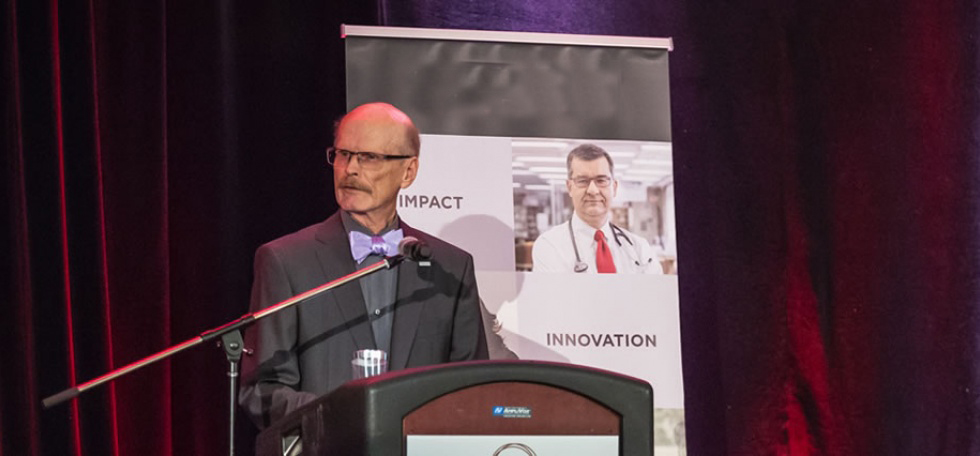Dr. Vernon Hoeppner

Dr. Hoeppner is a respirologist at the University of Saskatchewan. He finished medical school at the University of Manitoba and continued on to the University of Toronto to complete his general residency and Respiratory Specialty training. The Lung Association was instrumental in recruiting Dr. Hoeppner to Saskatchewan (SK) in 1977. Dr. Hoeppner is a respirologist who has been a leader in tuberculosis (TB) research for close to 40 years. He pioneered directly observed therapy (DOT) for Saskatchewan patients with TB and TB infection - the first jurisdiction in North America to provide this service. He continues to focus his research efforts on TB treatment and improvement of care.
In 1986, Dr. Hoeppner joined the SK Anti-Tuberculosis League as the Director of Tuberculosis and continued on when SK Health took over TB Control. He very quickly began implementing innovations in TB control, introducing DOT, and establishing mobile TB clinics in high-risk areas of Northern Saskatchewan. His research skills led to a thorough analysis of the outcomes of the TB Control program which resulted in major changes in areas such as prophylaxis treatment for the prevention of TB. He has published papers on topics such as the nature of TB in Canada’s First Nations people, has previously chaired the Canadian Tuberculosis Committee, and is a contributing author of Canada’s tuberculosis control guidelines. Dr. Hoeppner was the driving force in advocating for the provision of home oxygen therapy and home ventilation services for Saskatchewan people living with chronic lung disease. He chaired the SAIL Home Respiratory Therapy Committee and advised SAIL on respiratory matters for many years.
What problem is your research trying to solve?
Currently, our team is quantifying reinfection TB in Nunavut, Ontario, Saskatchewan, and Alberta using whole-genome sequencing (WGS) and translating the findings into best public health policy. Historically, we thought that anyone with recurrent TB had relapse TB, that is to say, it came from organisms already inside the body that began to grow again. Since the implementation of genotyping TB mycobacteria around 1990, it was determined that some recurrent TB organisms were a different genotype from the first episode. This was defined as reinfection TB, that is to say, the second episode came from an organism outside the body, from another person. These tests used a small fraction of the gene, about 100 - 1000 base pairs compared to about 4 million base pairs in the genome. Therefore we would expect WGS to result in significant refinement of the test. This has recently been confirmed with some WGS studies. We are applying this technique to patient cultures from the four jurisdictions. Reinfection has been reported to be linked to areas with high rates of TB. The two populations with the highest rates of TB in Canada are the indigenous and immigrant populations. These comprise most of our TB culture pairs.
What is the potential impact of this research for Saskatchewan residents?
With the greater precision of WGS, we hope to show more reliably the extent of reinfection TB in Canada, specifically in the four jurisdictions. By identifying reinfection TB it will be possible to better manage it. Managing reinfection TB is quite different from managing relapse TB. With the added precision of WGS, we hope to decrease the frequency of recurrent TB and with that the overall burden of TB.
What drew you to TB research?
As a trainee, I repeatedly encountered patients with TB. I discovered that the books presented details of TB superficially and few of the instructors had significant experience or understanding of TB. Many of my questions went unanswered. If I was to get answers, I had to do it with clinical experiments. As often happens in research, the answer to one question led to more than one additional question.
What projects are you looking to explore in the future?
We noted that TB rates reported by the Public Health Agency of Canada plateaued in Canada from 2004-2014. During this period US rates continued a regular downward trend. Since Canada and the US are both high-income low TB rate countries with virtually identical TB surveillance programs, we asked the question, why are Canada’s rates falling behind? Is Canada executing its TB Prevention and Control Programs (TBPCP) less effectively? Our team has just started a project with a detailed comparison of TB rates since 1953 to identify intervals of similarity and difference. For the intervals of difference, we will explore a spectrum of causes that could explain these differences. It is important to determine whether our TBPCPs are performing at the necessary and expected standard.
